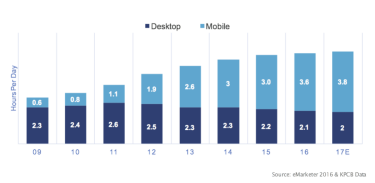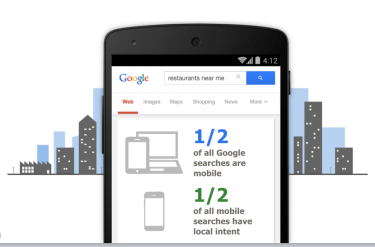
Structured Data, 5 Mobile Search Features That Will Make You Love It
What is Structured Data?
Structured data is a standardized code format that enables search engines to understand the content on your website using micro data. Google uses this code to display search outcomes in the format of rich snippets. Rich snippets are aimed to highlight important details about the content of your webpage like product ratings, recipe information, event location and more. The more you mark up your pages and use structured data the more information will be visible to a user. This usually leads to higher click throughs to your website. This is a must know for anyone who works in SEO, Content Marketing and digital marketing as a whole.
Click here to learn 5 SEO Tips to Drive Growth Like You Are Yoda
Schema markup is one of the most prominent types of structured data. Here is an example of the code from Schema.org for an event.
<div itemscope itemtype=”http://schema.org/Event”> <div itemprop=”name”>Spinal Tap</div> <span itemprop=”description”>One of the loudest bands ever reunites for an unforgettable two-day show.</span> Event date: <time itemprop=”startDate” datetime=”2011-05-08T19:30″>May 8, 7:30pm</time> </div>
In this example the data is structured using:
- itemscope & item type: Lets search engines know what the page is about. In this case an event and it references the event page on Schema.org
- itemname: Lets search engines know the name of the event.
- itemprop: Gives search engines additional information or properties of the event like startdate and time of the event.
Structured data is not new but it is becoming more important as consumers increase usage of mobile devices to search and find information.
Mobile Usage Changes Search Behavior
Mobile device usage has already surpassed desktop usage.

Which has increased the number of users who search on mobile phones versus desktops.

As well as increased mobile searches with local intent because people on the move usually want to find things close or near to them.

There are dozens of “right now” moments that we experience during the day. At Google, they call them “micro moments”:
- I-want-to-know
- I-want-to-go
- I-want-to-do
- I-want-to-buy
Today, it’s not a brand that really matters for users when they search. What matters is fulfilling their need in the moment. According to Google, “65% of smartphone users agree that when conducting a search on their smartphones, they look for the most relevant information regardless of the company providing this information”.
To make sure your product is found by users in the moment just being listed on a search engine is not enough. As search engines and the way, we search continue to evolve into areas like voice search Google is relying more and more on structured data. They have used this data to make search engine results more visual, informative, engaging and compelling.
Click the link to learn how Google is your Competitor in Search
If you don’t use structured data like Schema markup you won’t be able to show up on some of the mobile features below.
5 Mobile Search Features Built on Structured Data
People have evolved how they search, where they search and their expectations around the information and results they find. People are now searching on Pinterest, Facebook, YouTube, and Twitter so they expect visual and more dynamic results. Because of this Google is also evolving the way they deliver results on their search engine.
Click the link to learn advanced Google search functions to help you search like a pro.
Below are a few examples of search results improvements that Google launched using structured data markup.
1. Rich Snippets
Rich snippets are eye-catching pieces of information displayed in search results under hyper linked titles. They appear both in desktop and mobile SERP, but have crucial value for mobile queries, giving quicker access to the information a user is looking for.
Let’s say, you own a cooking website. If you mark up your recipes with images, ratings, cooking time and the number of calories, next time Google crawls your website all these details will be available for rich snippets on a search results page:

The key factor is to properly identify which information to mark up. Since there are different types of rich snippets, you should think which of them are relevant to your business. The most prominent markup used to show rich snippets is Schema markup.
Find more about how to mark up your content items.
Having structured data markups does not guarantee that your rich snippets will show in the search engine results page (SERP). It just makes them technically possible. But it’s definitely better to use this opportunity than ignore it and Google usually shows the data.
2. Rich Cards
Rich cards feature is a comparatively new format of presenting content previews on SERP. In search results they appear as a carousel of cards with pictures and brief product information. A user can swipe through the cards and look for the necessary content.
Mobile search results for: “Mexican recipes”

Launched by Google in May 2016, rich cards are considered to be the next evolution of rich snippets. Both are aimed to make mobile search results better by using structured data markups. But rich cards are not rich snippets. The difference is in the following functional limitations of rich cards:
- Available only on mobile devices and present only top search results;
- Cover limited content types: recipes, movies; recently expanded to restaurants and online courses;
- Appear only in the English language search results;
Check out Google Webmasters website for implementation details.
3. Similar Items
Earlier this year Google announced two new features within Google image search: Similar items and Style ideas. Both elements are available for mobile web and the Android Search app.
Similar items feature helps users to find products they love in photos found on Google Image Search. Using machine vision technology, the Similar items feature identifies products in lifestyle images and displays matching products to the user. Currently, the Similar items support handbags, sunglasses, and shoes and will cover other apparel and home & garden categories in the next few months.
How does it work? For example, I am looking through celebs’ images and come across the sunglasses that Victoria Beckham is wearing:

I absolutely like these sunglasses and want to buy them! I click on the image, scroll down and see the new feature in action – price and store information of the similar items are right there:

Now I can choose the sunglasses I like at the price I can afford. My instantaneous need to buy the product is satisfied in a couple of minutes!
4. Style Ideas
Style ideas feature shows users a grid of inspirational lifestyle images and outfits that showcase how the product can be worn in real life. A user can check which type of jeans or clothes look better with these boots that are currently on the mobile screen.


Also, the Similar item feature with prices and store details is in place:

To make your products eligible for Similar items and Style ideas features, you need to add and maintain product markup on your pages. Again, this markup helps Google find product offerings on the web and give users an at-a-glance summary of product info.
5. Image Badges
In August 2017 Google updated its Image Search interface on mobile with Image Badges. If you look at the image search results on your smartphone, you will notice square icons in the bottom corner of the photos marked with “product”, “recipe”, “video” or “GIF” signs. These badges are aimed to help users discover more through their mobile search results and suggest actions they can take.

If I want to make a cake myself, I will click on images with “recipe” badge, if I am looking for the cake to buy, I will check on “product” photo. So, I can find the answer to my queries right on the image search results page!
These badges are time-saving and effectively satisfy I-want-to-do and I-want-to-buy moments of your audience.
If you have images on your website, you can add badges by using appropriate structured data on your pages. If you’re publishing recipes, add Recipe markup, for products, add Product markup, and for videos, add Video markup.
To learn more about how to get badges to show up in Google Image search for your website, read the Google Webmaster blog.
In Conclusion You Better Love Structured Data
Structured data is powerful. It presents the content of your website to users in the most informative and efficient way. Its value increased significantly in the mobile search era when people expect to get instant and bite-size answers to their numerous micro-moment queries. Google has a goal to improve how mobile users in search find what they need. The company launches various search enhancing features to meet users’ needs and improve their search experience. Structured data is the core platform for the majority of these improvements. Make sure you are using structured data today.



